- Administrator
- Albums and Singles
 With mainstay Vincent De Roguin absent and Stephen O'Malley exercising sharp restraint, Æthenor have released their best album and maybe one of the best live recordings I have ever heard. Assembled from three shows recorded in Oslo, Norway during 2010, En Form For Blå captures Æthenor improvising a loose electric sound bound expertly together by the talents of percussionist Steve Noble and one-half of the Ulver crew. Together they create a surprisingly intelligible sound, which betrays its impromptu origin.
With mainstay Vincent De Roguin absent and Stephen O'Malley exercising sharp restraint, Æthenor have released their best album and maybe one of the best live recordings I have ever heard. Assembled from three shows recorded in Oslo, Norway during 2010, En Form For Blå captures Æthenor improvising a loose electric sound bound expertly together by the talents of percussionist Steve Noble and one-half of the Ulver crew. Together they create a surprisingly intelligible sound, which betrays its impromptu origin.
At first, I understood why VHF advertised En Form For Blå as a kind of jazz mutant. With Derek Bailey collaborator Steve Noble playing drums and the duo of Daniel O'Sullivan and Kristoffer Rygg producing atonal melodies using, among other things, a Fender Rhodes piano, records like Get Up With It were destined to be used as a point of reference. It is immediately evident, however, that Æthenor are not a jazz quartet and that they aren't making anything like jazz music. Their sound on En Form For Blå is almost totally unique, coming closer to a Pan•American/Music is Rotted One Note/Charalambides hybrid than Miles Davis or Herbie Hancock. Thanks to their fluid style, creative open-mindedness, and a nice editing job—there is no crowd noise—Æthenor make this improvised live recording sound like a studio album. In fact, it wouldn't be hard to mistake it for a soundtrack, film score and effects included.
O'Sullivan and Rygg provide the bulk of En Form's weight. They alternate between trembling bass swells, noise walls, and lighter-than-air melodies, but typically use some combination of each to generate microscopic interchanges and hallucinatory field recordings. If their instruments aren't squawking or breathing, they're rummaging, flinching, or even slithering around in an environment rife with minutiae. There are a few massive crescendos dotting the record, but in general they avoid the chaos of wall-to-wall noise and focus their efforts on lucid instrumental exchanges. Synthetic vamps, which sometimes creep into Pink Floyd territory, frequently anchor the proceedings and serve to concoct a thoroughly ritualistic tone, which is spacious enough to include silence and pianissimo dynamics.
On more than one occasion, however, Daniel and Kristoffer's disconnected scribblings congeal into a groove, the same way clouds unexpectedly transform into recognizable figures. For instance, during "One Number of Destiny in Ninety Nine," Æthenor spontaneously sculpt an Om-like dirge from a sea of squirming effects and churning distortion, turning a storm of noise into a swaying and exotic dance.
It was during such passages that I first noticed Noble's drum performances. Among the resonant synthetic tones and apocalyptic horn blasts, Noble carves out a whole world of scampering percussive noises and bellicose rhythms. Initially, his cunning approach to the drums sounds supplemental, but on song after song it is evident that his talents are essential to the record's success. In many cases, his imitative cadences take center stage, with O'Malley, Rygg, and O'Sullivan playing the supplemental role. The importance of his contributions cannot be overstated; without his enterprising approach, En Form For Blå would be a much less exciting, much flatter recording.
Without a doubt, Noble's work is the star of this show, but the restraint and collaborative ability that Stephen, Daniel, and Kristoffer demonstrate is equally essential. I would love to see this incarnation of Æthenor in concert for myself because I find it hard to believe a record as coherent as En Form For Blå could be the product of a live engagement. If all of their live performances are of as high a quality as this album suggests, then Æthenor has to be counted as one of the best live bands around.
samples:
 
Read More
- Administrator
- Albums and Singles
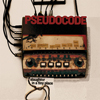 Although they appeared on a variety of compilations in the early 1980s, including the legendary Rising from the Red Sands, Pseudocode mostly remained unknown, putting out their own cassettes and the occasional odd 7", but never reaching the same levels of notoriety that contemporaries in the early industrial underground enjoyed. Nearly 30 years later, some of these earliest recordings have been issued, for the first time, in a deluxe double LP package.
Although they appeared on a variety of compilations in the early 1980s, including the legendary Rising from the Red Sands, Pseudocode mostly remained unknown, putting out their own cassettes and the occasional odd 7", but never reaching the same levels of notoriety that contemporaries in the early industrial underground enjoyed. Nearly 30 years later, some of these earliest recordings have been issued, for the first time, in a deluxe double LP package.
This Belgian trio, consisting of Xavier S (Thrills) on vocals, Alain Neffe (Insane Music) on synths and horns, and Sub Rosa co-founder Guy Marc Hinant on guitars were essentially caught up in the post-punk and early industrial movements that were ongoing when these tracks were recorded between 1980 and 1982, with only a few being released on compilations in edited forms.The full package feels like a pristine copy of a C90 uncovered by one of the band members, and presented beautifully to a world finally ready to hear it.
Pseudocode definitely had their own sound and style, but there are influences to be heard.The guitar noise and atonal vocals of "Growing Down" would have fit in on the first DAF album, even if the monotone drum machine pound wouldn't, and the filtered rhythms and synth stabs of "Cut Up" resemble Throbbing Gristle, even more so considering Xavier's sounds quite a bit like Genesis P-Orridge via the echo chambered vocals.
Given their source, it is not shocking that there’s a few tracks that meander a bit longer than they should.The cheap synths and random drum machine rhythms on "You're Not Alone" bounce around for most of the song without going anywhere until the final moments, when it locks into a more aggressive, pounding sound that ends too quickly."Flesh Shop" has the same feeling, with the skittering and delayed rhythms propelling a track, that feels like it could use some editing, but throws in everything but the kitchen sink, sonically.Well, not the kitchen sink, but it sounds like someone left The Cure's Seventeen Seconds playing on a tape deck somewhere in the studio.
The strongest songs are where the band seems to click together in their improvisations:the trashcan drums, dubby bass, and sax on "I Don't Say More" put a perverse skronk into the otherwise un-funky collection."Sad Song" has metronomic snare rhythms that belie the more complex pianet melodies and analog synths, pushing the song more into an early electro pop realm."Fight Back (The Angels)" has a combination of filtered guitar, chintzy beats, and robotic vocals that also seem to straddle that line between intentionally abrasive industrial noise and early stabs at synth pop, which reminded me of some of those early Cabaret Voltaire experiments.
While I don't think Pseudocode will be spoken of with the same hushed reverence we have for the likes of Throbbing Gristle or Suicide, there are a lot of rough gems here that are just fine without any polish.Rather than mimicking their influences, this trio clearly integrated them, but had their own thing going on.It might not be a revelatory lost classic of proto-industrial music, but it's still a fun album. Plans for future releases of unreleased works is in the pipeline.
samples:
 
Read More
- Administrator
- Albums and Singles
 Recorded together using similar techniques, but vastly different source materials, these two releases feel like different parts of the same whole, with both of them emphasizing Mathieu's balancing of texture and melody, to excellent effect, through the use of processed, pre-recorded compositions.
Recorded together using similar techniques, but vastly different source materials, these two releases feel like different parts of the same whole, with both of them emphasizing Mathieu's balancing of texture and melody, to excellent effect, through the use of processed, pre-recorded compositions.
Sourced from a mic’d gramophone playing 78rpm records from 1928 to 1932 with a cactus needle for a stylus, A Static Place has the more urgent, dynamic feeling to it.There is heavy use of hissing and layers of analog static to be heard on "Schwarzschild Radius", but it is used sparingly, burying processed choral arrangements and organ passages in its fuzzy warmth.
Vinyl surface noise is a bit played out in my opinion, which is why this disc excels in its measured approach to using it.There is far more overt use of the musical elements of the source material in the beautiful waves of sound, with the various forms of digital processing transforming, but not destroying, the music its created from.The two part title track clearly demonstrates this, with glistening, soaring melodies being teased out of the ancient vinyl, juxtaposing melody and texture, almost mimicking a journey through arid deserts and claustrophobic caves.The second part includes what must be piano tones and orchestra-like outbursts in its long journey.
"Dawn" seems to take even more of its source material to heart, intertwining jazzy melodies over what resembles rattling metal to create a slow piece that carries its beauty all the way to the final moments of the album.All five of the pieces display Mathieu's balanced hand in reshaping existing sound into beautiful new worlds.Probably due to their similar approach, I felt some parallels to Philip Jeck's work with turntables, but Mathieu is a singular artist that really sounds like no one else.
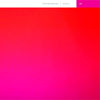
Remain, consisting of a single hour long track based upon Janek Schaefer's Extended Play, carries much of the same sensibilities of A Static Place, but instead projects it out into a long, sprawling work that has a slower, more deliberate pacing.Opening from quiet, open space, there are subtle vinyl clicks and pops that appear throughout, never being the focus but always adding to the album a slight sense of rhythm.
Early on there is a more pronounced leaning on the lower frequency spectrum, allowing bassy swells to appear abruptly, when they weren't as notable on A Static Place.There is an undercurrent of melody throughout the entire hour, but it doesn’t seem to be the focus; instead there is more texture and subtlety to be heard.There’s definitely "drone" elements, but I’m hesitant to say that since it has become almost a pejorative term, but here it applies in the most literal sense.
There is the same sense of comfort and warmth that carries over to here as well, with sustained notes that convey a familiar nostalgia that is universal.Throughout its full hour duration, the piece never seems to have a moment of filler, but slowly flows like a complex river of sound.It is haunting, with moments of sadness, darkness and triumph.
Both Remain and A Static Place share some definite qualities with one another, but each are their own album and focus on different compositional strategies by Mathieu.Remain is a slow building work, constantly evolving with a fluid sound to it, while A Static Place is more immediate, mostly due to the shorter pieces included.Both are gorgeous, evolving works of delicate melody and subtle texture, however, and I don't think I could pick a favorite between the two.
samples:
Read More
- Administrator
- Albums and Singles
 I don't understand how Erik Carlson has managed to stay so woefully underappreciated and low-profile for so long, as he has a very distinctive and appealing aesthetic.  Also, he has recently been largely infallible quality-wise. That hot streak continues here: wisely sticking closely to the sound he intermittently perfected with 2009's excellent Charmed Birds Against Sorcery, Carlson has delivered yet another impressive album of spidery, shimmering beauty.  It could benefit from a bit more bite though.
I don't understand how Erik Carlson has managed to stay so woefully underappreciated and low-profile for so long, as he has a very distinctive and appealing aesthetic.  Also, he has recently been largely infallible quality-wise. That hot streak continues here: wisely sticking closely to the sound he intermittently perfected with 2009's excellent Charmed Birds Against Sorcery, Carlson has delivered yet another impressive album of spidery, shimmering beauty.  It could benefit from a bit more bite though.
The core of Carlson's artistry lies in repetition, but he brings a deftness and lightness of touch to it that makes his vision uniquely his own.  Rather than sounding like a contemporary drone artist or a Reich-indebted minimalist, Erik manages to sound like a dream pop-damaged Oval: Map of Circular Thought is teaming with insistent glitchy-sounding loops that provide a rhythmic bed for warm organ drones and fragile, twinkling guitars.  On the album's lesser songs, the music shimmers and glitters quite pleasantly, but the pieces that truly shine are those where Carlson works a dark undercurrent into his narcotic dreamscapes like "Felt, Not Seen."  Around the ten-minute mark, the previously toothless reverie begins throbbing and quavering quite ominously and the remaining third of the song is spent in a disquieting nightmare.  The transition from light to dark is a very unexpected and seamless one, which is one of the things that I love so much about Area C: the mood of a song can turn with absolutely no warning.  It's a great trick– I wish Erik did it more often, but I guess I would start to expect it then (which, of course, he has probably already anticipated).  I cannot hope to outwit him.
In general, it is the longer songs that work best here, such as "In Toward the Wires" or the slowly pulsing drone epic "Ebbs to a Steady Burn," as Carlson is at his most emotionally rich and dazzling when he gives himself a lot of time to work.  Area C definitely requires some patience to fully appreciate, as Erik works very slowly and painstakingly: his intricate lattices of hazy drones and sparkling treated guitars are in no hurry at all to build to their full mesmerizing power.  Many of the shorter pieces boast some striking passages too, but hypnotic repetition, attention to nuance, and layering tend to be most effective when I am fully immersed in a song.  Area C is time-lapse photography for the ears.
As a progression from Charmed Birds, Map of Circular Thought is a bit of a lateral move.  On the one hand, it is clear that Carlson has become still more adept at compositional tactics like artfully weaving together multiple tracks, creating a pulse, and transitioning from one mood to another.  Also, I think his mood palette has expanded a bit.  However, he seems to have taken a significant step backwards texturally, as the lack of occasional bursts of harshness makes the woozy, looping, dreaminess of the album drag a bit.  Such touches do make some appearances, like the guitar noise and feedback in "In Toward the Wires," but they're often too submerged in the mix to make the needed impact.  Charmed Birds' better pieces were enhanced quite a bit by the well-timed use of scrapes, static, and voice snippets and I think those elements provide a very necessary counterbalance to Area C's drifting warmth.  I wouldn't be frustrated if I didn't have extremely high expectations though.  This is definitely a fine album by a master of his craft, but it is a bit too perfect and grit-free to be his masterpiece.
 
Read More
- Administrator
- Albums and Singles
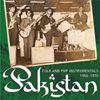 This album is very deceptively packaged and presented, but in the best way possible: the tame cover art and the word "folk" did nothing at all to prepare me for the extremely fun and quirky pseudo-surf gems within.  Of course, many of these pieces were originally folk songs, but they have been so jazzed-up with kitschy organs and twangy, tremelo-happy guitars as to make that term a wildly misleading understatement. Curator Stuart Ellis has assembled an improbable monster of a compilation.
This album is very deceptively packaged and presented, but in the best way possible: the tame cover art and the word "folk" did nothing at all to prepare me for the extremely fun and quirky pseudo-surf gems within.  Of course, many of these pieces were originally folk songs, but they have been so jazzed-up with kitschy organs and twangy, tremelo-happy guitars as to make that term a wildly misleading understatement. Curator Stuart Ellis has assembled an improbable monster of a compilation.
Ellis unknowingly started working on this album in 2005, when he begun making mix CDs (and then box sets) of obscure world music for himself and his friends.  Gradually, he became more and more interested in how rock music manifested itself in non-western cultures.  Also, his record scavenging and trading began bringing him in contact with like-minded people scattered across the world. As a result, the project quickly blossomed into the excellent blog Radiodiffusion Internationaal and eventually led to the curation of 2008's Bollywood Steel Guitar compilation on Sublime Frequencies.Although Ellis's blog isn’t especially fixated on Pakistan (his tastes are pretty wide-ranging), the period covered here is pretty fascinating, largely undocumented, and quite short-lived: the Pakistani's embraced rock in a big way, but the recorded evidence of that phase does not sound much like any American or British rock that was happening (except for maybe the Ventures or The Shadows).  It is easy to see why he chose it for a subject.
The handful of artists collected on this double album are an eclectic bunch, ranging from respected film composers to largely forgotten bands that only managed to release one single.  Or sometimes even less, as The Bugs just got the B-side of the Do Raha soundtrack single and The Bluebirds' sole recorded output is just a few pieces on a film music compilation.  The material itself is no less varied, as the only way to get a record released at the time was to either cover a traditional song with rock instrumentation (possibly with some electric sitar thrown in) or to contribute to a film soundtrack.
Within those unusual confines, however, these young musicians went in some unexpected and inspired directions.  For example, The Panthers spice up the traditional "Bhairvi" with swooning, woozy guitars, while The Bugs pump up the thumping Do Raha theme with enthusiastic electric sitar and a catchy accordion motif.  My favorite piece is probably the noir-ish/spy movie-sounding "Aay Jays Theme," but this is a surprisingly good album from start to finish.  I suspect a lot of that has to do with the fact that this whole project has been organically unfolding for so long that throwing together two albums of killer Pakistani rock for a compilation was no problem at all for Ellis.  As a whole, I prefer the more "garage rock" interpretations to the more psych-inspired ones or those that just sound like folk songs played on the wrong instruments, but I never find myself skipping anything when I put this album on–Stuart's judgment is unerring.  In fact, I find that I like a lot of these pieces much more than I like the Western bands that influenced them.
Of course, the Pakistan captured here is quite a different place from Pakistan now, as long hair, rock music, wild nightlife, and drugs were pretty damn rampant during that country's brief cultural explosion.  Unfortunately, all good things must end and that momentum came to an abrupt end when a 1977 coup resulted in the institution of a markedly less rockin' and hashish-friendly Islamic state, causing many of the key musicians in the scene to move to North America and the UK.  Notably, Ellis has actually managed to contact some of them over the years and was often greeted with bewildered questions like "Why do you like this stuff?" or "Why do you care?"  That, of course, is the hallmark of any truly great Sublime Frequencies compilation: finding great music so ephemeral and forgotten that even the musicians themselves are left baffled and surprised.
Samples:
- The Aay Jays - "The Aay Jays Theme"
- The Panthers - "Bhairvi"
- The Bugs - "Theme from "Do Raha""
 
Read More
- Administrator
- Albums and Singles
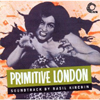 Perhaps uniquely, Basil Kirchin’s appreciators include Broadcast, Coil, Sean Connery, Elizabeth Taylor, Brian Eno, and Nurse With Wound. Included here is music from his first film score Primitive London (1965) and the gangland movie The Freelance (1971). Kirchin was a pioneering twentieth-century master of texture and mood. His inventive, multifaceted music still sounds light yet off-kilter, eerie yet peaceful, both futuristic and nostalgic.
Perhaps uniquely, Basil Kirchin’s appreciators include Broadcast, Coil, Sean Connery, Elizabeth Taylor, Brian Eno, and Nurse With Wound. Included here is music from his first film score Primitive London (1965) and the gangland movie The Freelance (1971). Kirchin was a pioneering twentieth-century master of texture and mood. His inventive, multifaceted music still sounds light yet off-kilter, eerie yet peaceful, both futuristic and nostalgic.
In the north London of December 1941, with the worst of The Blitz only just passed and rationing and nightly trips to the bomb shelter still in place, the teenage Basil Kirchin played drums in his dad’s jazz band. If that sounds gritty but humdrum, consider that The Kirchin Band evolved a highly percussive Latin-flavor which became so popular and respected that neither Sarah Vaughan nor Billy Eckstine would tour England without an assurance they would provide backing. Eckstine pronounced them the equal of the bands of Basie, Ellington, and Gillespie, and stated his disbelief that the group "aren’t American let alone that they are not coloured." Unusually, they had their own sound system which enabled Kirchin to record their performances. They were also recorded by George Martin, had movie star fans, and came near the top of several Melody Maker polls.
However, Basil Kirchin was not content to be, in his own words "a prisoner of rhythm." Born in Blackpool, he spent his last years in Hull. These towns in Northern England are on opposite (East/West) coasts yet only 111 miles apart. Kirchin, though, traveled much further, in both geographical and musical terms. Keen on exploring his own musical direction, he journeyed to India, Australia and the US. Upon returning to England, he embarked on various projects including writing music for imaginary and real films, and for the De Wolfe music library (with such excellent artists as Big Jim Sullivan, Tubby Hayes, Jimmy Page, and Kenny Wheeler). Kirchin also created his Worlds Within Worlds concept. This was an idea set in motion after a grant to purchase a cutting-edge Nagra tape recorder allowed him to slow down the sound of insects, birds, autistic children, gorillas, or whatever, to reveal sounds previously unheard. In this, he was miles ahead. (Years later, Eno would comment that slowing recorded sounds by more than fifty percent "does something to the timbre of sound...by bringing upper harmonics into hearing range".)* To these slowed sounds, Kirchin added cello, horns, and organ to produce two albums of pioneering musical soundscapes. Unfortunately, these have never heard been as intended: since Colombia and Island took turns to betray him and ruin his recordings.
The film Primitive London contains images as banal and sordid as those suggested by Kirchin’s weird, yet somehow "correct" mix of sounds, and a bizarre treat awaits its viewers. The score is by turns melancholy, melodic, repetitive, and sinister; tottering like a drunk in heels staggering home with the sun coming up on a beautiful day. Kirchin’s dreamlike atmospheres balance on the edge of oddness and optimism, without plunging headlong into either: a superb fit for the sense of tension which the film depicts, between the ordinary life of milk bottles and farms and that of wife-swapping and strip clubs. The recurring musical themes are simple and insistent yet Kitchin achieves contrast through varying pace and texture. Consequently, in the space of a few bars the mood can swing from sleazy to mundane and back again.
Kirchin’s film music is included in television productions and at least ten movies including Catch Us If You Can (a vehicle for the Dave Clark Five, 1965), I Start Counting (with Jenny Agutter, 1968), The Shuttered Room (Oliver Reed, 1967), and perhaps most famously The Abominable Doctor Phibes (starring Vincent Price, 1971). Also available on Trunk records by Basil Kirchin are Quantum, Charcoal Sketches/States of Mind, Abstractions of The Industrial North, and the slightly disappointing Particles. Also featured on Abstractions are selected cues from all the ten inch De Wolfe recordings from the same year (1966) including "Viva Tamla Motown" and "Pageing Sullivan" (named for the two featured guitarists).
The Primitive London release has the usual fine photographs and affectionate, enthusiastic and unpretentious sleeve notes we have come to expect from Trunk. Basil Kirchin deserves no less for if the histories of the genres of "library" and "ambient" music are ever set down, his name will be prominent in both. He was still working well into his 70s, hoping to leave signs to help younger people find their own ways to break out of creative constraints. "The challenge is to act before thinking," Kirchin remarked in 2003, just two years before his death.
* As quoted in Brian Eno: His Music and the Vertical Color of Sound by Eric Tamm.
Read More
- Administrator
- Albums and Singles
 The first offering in four years from folk-rockjourneyman David Berman could easily have become a messy affair. Afteryears of booze, drugs, depression, and more booze, it seemed Berman waspoised to make the all important recovery record. It's a familiar one—it reeks of sorrow, redemption, and rehab—but Bermanknows he’s better than that, and as a result he’s peppered the newSilver Jews record with strange but brilliantly told tales of boozers,black Santa Clauses, and airport bartenders.
The first offering in four years from folk-rockjourneyman David Berman could easily have become a messy affair. Afteryears of booze, drugs, depression, and more booze, it seemed Berman waspoised to make the all important recovery record. It's a familiar one—it reeks of sorrow, redemption, and rehab—but Bermanknows he’s better than that, and as a result he’s peppered the newSilver Jews record with strange but brilliantly told tales of boozers,black Santa Clauses, and airport bartenders.Drag City
Opener “Punks in theBeerlight” tears out of the gate with a ferocity rarely heard inBerman’s previous work, and its tale of puking into paper bags and“burnouts in love” ensures that this will not be your typical recoveryalbum. While past Silver Jews records expertly mined the “aw shucks”alt-country vein with often excellent results, Tanglewood Numbers seesthe band entering a much more rock direction, a move seen on songs like“Sometimes a Pony Gets Depressed.”
Although much of the album isconsistently good, I have to confess that I find the new “rock” sound abit contrived and less appealing than the shambling country approachfound on previous efforts (American Water comes to mind). Berman ismost effective when he’s there sharing the bottle with you, not onstage playing his guitar. As a result it is a good album that suffersfrom a split personality. A rock album has to rock, and thoughTanglewood Numbers does carry more sneers than its predecessors, itcan’t shake the feeling that it’s misplaced. Even so, the album isbalanced out by several standout tracks.
“K-Hole” features some ofBerman’s most desperate vocals, with him intoning “I’d rather live in atrashcan/ than see you happy with another man.” And while it would seemthat the overall mood of the record is all dark clouds and stormydepression, Berman does us the favor of lightening the mood withrollicking numbers like “I’m Getting Back Into Getting Into You” and“How Can I Love You (If You Won’t Lie Down)”, which features the warmbacking vocals of his wife Cassie Marrett.
Though it featuressome questionable shifts in approach, Tanglewood Numbers highlightsensure that it will be a worthwhile entry to the Silver Jews canon.
samples:
Read More
- Administrator
- Albums and Singles
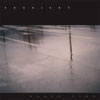 It's an attractive package on the most base level. The liner notes claim, "Desire is the root of all suffering," and the artwork depicts a woman, possibly a prostitute, in some form of bondage. Paired with the rather bleak photographs of nondescript locales, the entire album screams before it ever begins playing. This stuff is vile: the album is dirty, absolutely filthy, and exciting.
It's an attractive package on the most base level. The liner notes claim, "Desire is the root of all suffering," and the artwork depicts a woman, possibly a prostitute, in some form of bondage. Paired with the rather bleak photographs of nondescript locales, the entire album screams before it ever begins playing. This stuff is vile: the album is dirty, absolutely filthy, and exciting.Dominick Fernow is a formidable presence live. Typically shirtless, he requires only two microphones and some large amplifiers to extract the shriek and roar of victims who've succumbed to some violent act. His noise is visceral and muscular, masculine in a savage and homicidal sense, and the result live usually involves injury and complete absorption; there's absolutely no way anyone's attention could be anywhere but on him. On record he's fucking loud, the kind of loud that will get the cops called to your house because the neighbors think something is exploding and the house might burn into flames at any moment. The music is dense and my experience with Fernow's work is that there's never really a moment of silence or a space anywhere in the noise. It just keeps coming and coming until eventually it strips the paint off the walls and ejaculates it back in my face.
Black Vase is slightly different for a couple of reasons and those reasons make this a better album. First, drums and synthesizers make an appearance and provide fairly consistent rhythm to a few tracks whose sole instrument is Fernow's voice going completely off the edge and the mics shrieking their ear-shattering madness over and over again. A song like "Sorry Robin" benefits from these additions, sounding like a perverse new wave experiment in torturing small animals and children. The feedback rendered in the song takes an almost melodic role and the drums simply pound away in tribal fashion, eventually overloading the whole piece with Fernow shouting his strange lyrics. Those lyrics constitute the second aspect of his work that is either the most appealing or the most revolting aspect of Prurient. Undoubtedly sexual and almost certainly meant to emanate a violent attribute, Fernow's lyrics sound possessive and psychotic, the product of a child forced to live in a basement and meditate solely on what he can hear through the floorboards: his mother being beat or his father womanizing over the years.
The lyrics can sound a bit amateur at times, reaching from some erotic conclusion but not quite getting there because of the favor Fernow takes towards bluntness. A track like "Lord of Love," on the other hand, is perfect, ambiguously situated in some kind of cross-dressing fantasy created by an infatuation with a nameless woman. As excellent as Fernow is at forging harsh noise extravaganzas, he shines when he exhibits the ability to craft multi-layered songs that are as brooding as they are caustic. I get the feeling Black Vase could've been even more powerful if Fernow had decided to contain himself slightly more and fine-tune the record. Sometimes the silence is far scarier than the burst of anger of the explosion of hatred that accompanies death.
samples:
Read More
- Administrator
- Albums and Singles
THE NEW CURRENT 93 ALBUM and other C93/Coptic Cat news 4 February 2011
|
HONEYSUCKLE ÆONS
AMEN STAUROS
The new Current 93 album The new album by C93 is titled HoneySuckle Æons. It will be released at the Athens show on 24 March 2011 and will be available at the other subsequent C93 concerts on the tour. It will also be available from the Coptic Cat shop and will be sent out on 24 March. Coming soon... Amen Stauros.
Current 93: ‘Thunder Perfect Mind’ to be played live simultaneously with David Tibet’s lyric book launch “Bloody smoke, foggy smoke, beginnings and endings…” We are delighted to announce that David Tibet, Michael Cashmore and Current 93 will be performing the entirety of their Hallucinatory Playtime Dream Cycle, THUNDER PERFECT MIND, in (almost definitely) London whilst simultaneously launching David Tibet’s long-awaited lyric book, SING OMEGA (previously titled Under the Rain and Teeth of Gods). Due to the nature of their rehearsals, and the availability of our chosen venue, this concert is likely to take place in July 2011—meaning a brief postponement from the previously-mentioned March publication date—but it is very important to Michael and David to bind together these two events and make each of them into as Hallucinatory a Playtime Dream as possible. It is likely C93 will be performing two nights. More details very soon. Click here to buy Thunder Perfect Mind from Coptic Cat (2CD or download) or here to buy it from Jnana Records (2CD).
Current 93 cloth bags re-ordered
There have been a lot of emails asking about the Thunder Perfect Mind and Dogs Blood Rising/There’s No Hiding from the Blackbird cotton fairtrade bags which sold out very quickly. We have just re-ordered both of these—the Thunder Perfect Mind bag will be in the blue/green/jade we call ByrdColour, and the Dogs Blood Rising/There’s No Hiding from the Blackbird bag in the same red/black as before.
C93 German and (possibly) Danish dates added to March tour C93 hope to play play their first-ever Scandinavian show in Denmark as part of their forthcoming tour, but this is not yet confirmed. More details as and when we have them. An extra German date has been added, at Cologne/Köln Stadtgarten on 29 March. We hope to see you there, as real as rainbows.
David Tibet ‘Baalstorm, Sing Omega’ original artwork for sale David has added four pieces of his original artwork for Baalstorm, Sing Omega to the original artwork section of the Coptic Cat website. The first is ‘She is Naked Like the Water’, the painting used for the front cover of the CD and vinyl LP album; this piece is approximately (30 × 30 cm/12" × 12"), crayon and white ink on black paper. The second and third are, respectively, ‘Anoükiem et Anok in Storm’ and ‘The Assault Against Christ and the Four Apostles by the False Moon and her Legions’ which were two more of the paintings David made whilst working on Baalstorm, Sing Omega for possible use in the album artwork. These pieces are both A4, crayon and white ink on black paper. ‘Anoükiem et Anok in Storm’ is presently in the hands of Devendra Banhart, who is including it along with two more pieces by David in a large group exhibition he is curating in Mexico City in February—more details of this exhibition follow below. The fourth and final piece, ‘ZOSer and Pavo Ascend as Egypt’, is now in the collection of Uwe Henneken and Katja Strunz and is being exhibited at the Berlin show mentioned elsewhere in this update. All pieces can be found in the original artwork section of the website.
David Tibet ‘I Have Seen the Gnostic Awe and All’ original artwork for sale David has also added images of the nine paintings in his I Have Seen the Gnostic Awe and All series which he did for the Fabio Quaranta T-shirt collection that will be released in the Autumn of 2011. ‘I Have Seen the Gnostic Glory 2’ is presently in the hands of Devendra Banhart, who is including it along with two more pieces by David in a large group exhibition he is curating in Mexico City in February—more details of this exhibition follow below. All pieces can be found in the original artwork section of the website.
Test pressing of C93 7" available
There are eight copies available of the black vinyl 7" test pressing of the C93 single, ‘Time of the Last Persecution’/‘Black Flowers, Please’. It comes in the original sleeve, signed by David, and has white labels with the title and the group’s name written in black ink by David. They are £75 each plus postage and packing. Please email
Unique C93 test pressing box sets added to eBay Two box sets have been added to eBay at the links below. There is only one copy of each. One is the Like Swallowing Eclipses box set of Andrew Liles and C93’s reworking of early album material. This has all six albums as white label test pressings, with the titles handwritten by David. Also included is a piece of original artwork by David which was done for the box set but never used. The box set includes: the proper printed LP covers (into which the test pressings are inserted), the double-sided colour photographic insert and the printed box. So: this item is the same as the standard box set release, but with handwritten white label test pressings and the extra original artwork. The other is a test pressing of the German Vinyl on Demand Current 93 box set. This contains all eight white label 12" black vinyl test pressings, and the white label 7" black vinyl test pressing that was available to subscribers to VoD only. The records are housed in two black wooden silkscreened boxes which themselves come in a beautiful fine-linen silk-lined box with a Coptic text design by David on it. Each label has the titles handwritten by David. It contains all the original items from the original box set, which sold out on pre-order. So, this is identical to the subscribers’ edition of the box set except that the records are white label test pressings with handwritten labels; there was a small number of black card boxes, containing all the test pressings, with a drawing by David on the front of the box; these were sold privately. This box set is the only one in which the labels are handwritten. A list of what is in the two box-sets follows. Please notice this box set is very heavy, so be aware that the postage cost will reflect that.
Stapleton-Tibet album CD reissues We are now working on the reissue of the two albums that David Tibet and Steven Stapleton recorded together. Both will be 2CD digipaks. The Sadness of Things will contain the two tracks from the original album, as well as ‘The Fire of the Mind’ from the Simply Being book by James Low and an alternate mix of ‘The Grave and Beautiful Name of Sadness’, whilst Musical Pumpkin Cottage will feature the two tracks from the CD album of the same name, the alternate mixes of those tracks that were released first on the vinyl album Musicalische Kürbs-Hütte and then later on the Octopus CD and the track ‘I Left Her for a Cartoon Octopus’, also released on the Octopus CD. More details as soon as they ready.
Don Bradshaw-Leather CD reissue David is meeting Don Bradshaw-Leather’s sister once again when she returns to England in March/April to discuss the Coptic Cat reissue of her brother’s masterpiece Distance Between Us. This project is taking longer than we had both envisioned due to her recent relocation outside of the UK. She is very keen (as I am) to find extra material for the issue—photos, texts and perhaps even music. The release is still absolutely on and we are planning for it to be out later this year.
David Tibet painting in Berlin group exhibition David has his painting ‘ZOSeR and Pavo ascend as Egypt’, which was used on the insert of the vinyl edition of Baalstorm, Sing Omega, on display at a group show called ‘La Vallée Patibulaire’ between 25–27 February at Caro Bittermann, Gustav Müller Str. 18, 10829 Berlin. Opening times: Friday 25 February: 6–10pm; Sat 26–Sun 27 February: 12–6pm. www.vallee-patibulaire.eu.
David Tibet paintings chosen by Devendra Banhart for Mexico exhibition David is Over the Æon to have had three of his paintings chosen by the loveliest Devendra Banhart for a group exhibition entitled ‘La Migra!’ that Devendra is curating in Mexico City. The paintings are ‘Anoükiem et Anok in Storm’, ‘This Day You Will Be With Me in Paradise’ and ‘I Have Seen the Gnostic Glory 2’. The exhibition opens on 23 February. The exhibitors are as follows: Zach Hill • Marc Bell • Eric Wareheim • Jerry Hsu • Beck • Melissa Shimkovitz • Kevin Long • Adam Green • David Tibet • Marilyn Manson • Fabrizio Moretti • Alia Shawkat • Nat Russell • Thomas Campbell • Travis Keller • Angeline Rivas • Keegan McHargue and Adam Tullie with one more person tba… The show will be held at VICE GALLERY, Mérida 109, esq. Alvaro Obregón Col. Roma, Mexico City. www.viceland.com/mx
This update has been written by me, Anok Pe David Tibet, in |
Read More
- Administrator
- Albums and Singles
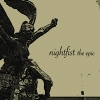 The immediate reaction I had to my first airing of this CD is probablyquite common: It's impossible, at first, to believe that this isgenuine. Thankfully, the intensity and craftsmanship of the music lenda great deal of credibility, and after repeat listens I am less andless inclined to challenge the band on whether or not their hearts aretruly in this. I grew up listening to Slayer, Anthrax, and Metallica,sporting the worst mullet on the planet and a backpatch on my denimjacket to strike fear into all those who opposed. As I grew older, Igot into Yes, Dream Theater, and even some King Crimson, and learnedhow expansive one could make rock sound. Nightfist have taken the worksof these and other collective metal and prog-rock influences andbettered them, even if only here and there on their first release. Iftheir bio is indeed true and Nightfist's members are recent high schoolgraduates, then color me doubly impressed, as there's not one slip-upis to be found in these louder-than-love anthemic passages, and thatkind of skill is rare on music so technically precise as this. Theprologue and epilogue come off a bit forced, like an afterthought,detailing the warrior's journey in two brief monologues; thankfullythey let the music do most of the talking. Furious drumming, blazingguitars and mad-scientist keyboards abound, and the songs take on alife of their own. I saw the warrior, put upon by so much strife,swinging his sword and crushing enemies with one blow, striving towardsthe final battle. The entire CD is a metaphor for this up and comingband, and at this rate they'll be the stuff of legends sooner ratherthan later.
The immediate reaction I had to my first airing of this CD is probablyquite common: It's impossible, at first, to believe that this isgenuine. Thankfully, the intensity and craftsmanship of the music lenda great deal of credibility, and after repeat listens I am less andless inclined to challenge the band on whether or not their hearts aretruly in this. I grew up listening to Slayer, Anthrax, and Metallica,sporting the worst mullet on the planet and a backpatch on my denimjacket to strike fear into all those who opposed. As I grew older, Igot into Yes, Dream Theater, and even some King Crimson, and learnedhow expansive one could make rock sound. Nightfist have taken the worksof these and other collective metal and prog-rock influences andbettered them, even if only here and there on their first release. Iftheir bio is indeed true and Nightfist's members are recent high schoolgraduates, then color me doubly impressed, as there's not one slip-upis to be found in these louder-than-love anthemic passages, and thatkind of skill is rare on music so technically precise as this. Theprologue and epilogue come off a bit forced, like an afterthought,detailing the warrior's journey in two brief monologues; thankfullythey let the music do most of the talking. Furious drumming, blazingguitars and mad-scientist keyboards abound, and the songs take on alife of their own. I saw the warrior, put upon by so much strife,swinging his sword and crushing enemies with one blow, striving towardsthe final battle. The entire CD is a metaphor for this up and comingband, and at this rate they'll be the stuff of legends sooner ratherthan later. Read More
- Administrator
- Albums and Singles
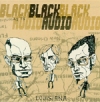 The future of indie rock mixed with electrorock funk is definitely indoubt. Black Audio are a Finnish pop outfit with a mission to be thebest club band ever, or so it seems listening to their slickproductions on this release. The sad thing is that their beats arederivative, and every track is ruined by the mispronunciation of aword, or a strange effect that throws everything out of balance. Thereis a lot of creativity in their music, no question there, but it hasvery little substance that can be called originality. This single,composed of one undisturbed track off their debut album and two remixedversions of album tracks, is enough to give a taste of the band andtheir flavor, but there is precious little here that would give me anycause to want to listen to their full-length at all. "Louisiana" iskeyboard funk with scratch guitar and a steady programmed beat, butit's crippled by the flatulent keyboard bassline, and the repeatedphrasing of "Yamaha" as "Ya-MAH-ha." "Rock 'N' Roll Egos" starts offfairly strong, with a labored rhythm and guitar bend, but it's thelyrics that ultimately do this one in, as well: "Yeah I hate therednecks, dislike hipsters even more/Getting along with mean morons forthe sake of business makes me a whore." It just shows that subjectmatter only gets you halfway there; next you have to carry the conceptto the masses on your words and feelings. Maybe something is lost inthe translation here, and that's part of the problem. "Mockba 1980" isa tribute to Finnish Olympic medal winners of the past, but the remixhere just plods at first, then annoys at the end with its blandkeyboard sounds and rapid-fire for no reason beat. It's a good attempt,and maybe there would be more on the full-length for me to enjoy. Withthis as an appetizer, though, I have very little stomach for the maincourse.
The future of indie rock mixed with electrorock funk is definitely indoubt. Black Audio are a Finnish pop outfit with a mission to be thebest club band ever, or so it seems listening to their slickproductions on this release. The sad thing is that their beats arederivative, and every track is ruined by the mispronunciation of aword, or a strange effect that throws everything out of balance. Thereis a lot of creativity in their music, no question there, but it hasvery little substance that can be called originality. This single,composed of one undisturbed track off their debut album and two remixedversions of album tracks, is enough to give a taste of the band andtheir flavor, but there is precious little here that would give me anycause to want to listen to their full-length at all. "Louisiana" iskeyboard funk with scratch guitar and a steady programmed beat, butit's crippled by the flatulent keyboard bassline, and the repeatedphrasing of "Yamaha" as "Ya-MAH-ha." "Rock 'N' Roll Egos" starts offfairly strong, with a labored rhythm and guitar bend, but it's thelyrics that ultimately do this one in, as well: "Yeah I hate therednecks, dislike hipsters even more/Getting along with mean morons forthe sake of business makes me a whore." It just shows that subjectmatter only gets you halfway there; next you have to carry the conceptto the masses on your words and feelings. Maybe something is lost inthe translation here, and that's part of the problem. "Mockba 1980" isa tribute to Finnish Olympic medal winners of the past, but the remixhere just plods at first, then annoys at the end with its blandkeyboard sounds and rapid-fire for no reason beat. It's a good attempt,and maybe there would be more on the full-length for me to enjoy. Withthis as an appetizer, though, I have very little stomach for the maincourse.Read More

































